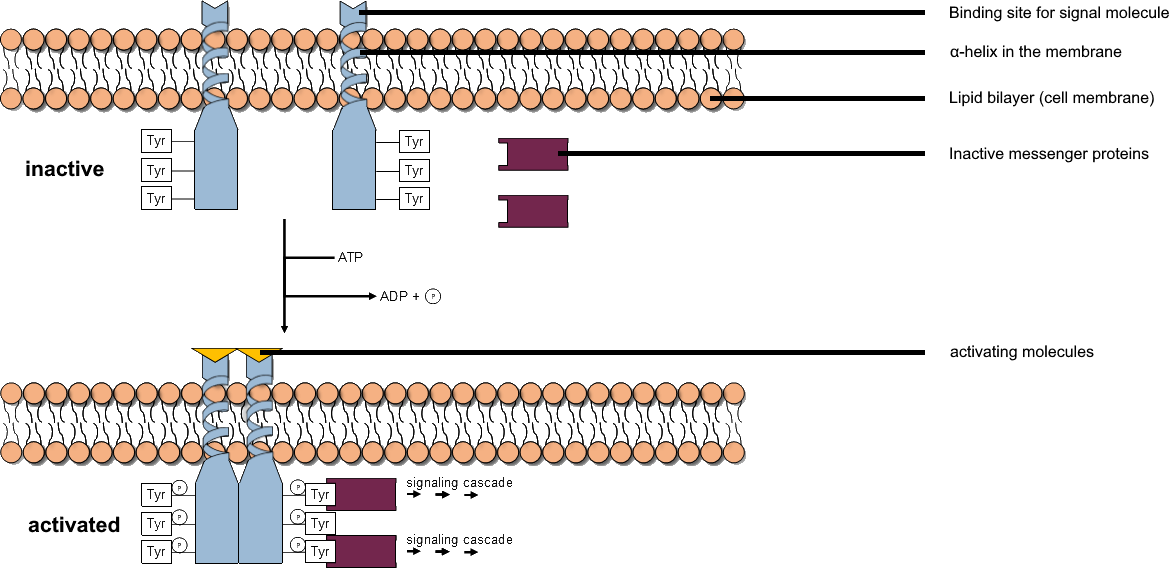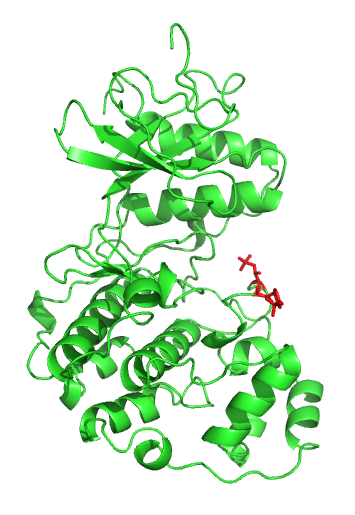|
FMS-like Tyrosine Kinase 3 Ligand
Fms-related tyrosine kinase 3 ligand (FLT3LG) is a protein which in humans is encoded by the ''FLT3LG'' gene. Flt3 ligand (FL) is a hematopoietic four helical bundle cytokine. It is structurally homologous to stem cell factor (SCF) and colony stimulating factor 1 ( CSF-1). In synergy with other growth factors, Flt3 ligand stimulates the proliferation and differentiation of various blood cell progenitors. For example, it is a major growth factor stimulating the growth of dendritic cells. FLT3L functions as a cytokine and growth factor that increases the number of immune cells (lymphocytes (B cells and T cells)) by activating the hematopoietic progenitors. It acts by binding to and activating FLT3 (CD135) which is found on what (in mice) are called multipotent progenitor (MPP) and common lymphoid progenitor (CLP) cells. It also induces the mobilization of the hematopoietic progenitors and stem cells in vivo which may help the system to kill cancer cells. FLT3L is crucial for ... [...More Info...] [...Related Items...] OR: [Wikipedia] [Google] [Baidu] |
Protein
Proteins are large biomolecules and macromolecules that comprise one or more long chains of amino acid residue (biochemistry), residues. Proteins perform a vast array of functions within organisms, including Enzyme catalysis, catalysing metabolic reactions, DNA replication, Cell signaling, responding to stimuli, providing Cytoskeleton, structure to cells and Fibrous protein, organisms, and Intracellular transport, transporting molecules from one location to another. Proteins differ from one another primarily in their sequence of amino acids, which is dictated by the Nucleic acid sequence, nucleotide sequence of their genes, and which usually results in protein folding into a specific Protein structure, 3D structure that determines its activity. A linear chain of amino acid residues is called a polypeptide. A protein contains at least one long polypeptide. Short polypeptides, containing less than 20–30 residues, are rarely considered to be proteins and are commonly called pep ... [...More Info...] [...Related Items...] OR: [Wikipedia] [Google] [Baidu] |
Multipotent Progenitor
Lymphopoiesis (lĭm'fō-poi-ē'sĭs) (or lymphocytopoiesis) is the generation of lymphocytes, one of the five types of white blood cells (WBCs). It is more formally known as lymphoid hematopoiesis. Disruption in lymphopoiesis can lead to a number of lymphoproliferative disorders, such as lymphomas and lymphoid leukemias. Terminology Lymphocytes are blood cells of lymphoid (rather than the myeloid or erythroid) lineage. Lymphocytes are found in the bloodstream and originate in the bone marrow, however, they principally belong to the separate lymphatic system, which interacts with the blood circulation. Lymphopoiesis is now usually used interchangeably with the term "lymphocytopoiesis" – the making of lymphocytes, but some sources distinguish between the two, stating that "lymphopoiesis" additionally refers to creating lymphatic tissue, while "lymphocytopoiesis" refers only to the creation of cells in that tissue. It is rare now for lymphopoiesis to refer to the creatio ... [...More Info...] [...Related Items...] OR: [Wikipedia] [Google] [Baidu] |
Tyrosine Kinase
A tyrosine kinase is an enzyme that can transfer a phosphate group from ATP to the tyrosine residues of specific proteins inside a cell. It functions as an "on" or "off" switch in many cellular functions. Tyrosine kinases belong to a larger class of enzymes known as protein kinases which also attach phosphates to other amino acids such as serine and threonine. Phosphorylation of proteins by kinases is an important mechanism for communicating signals within a cell (signal transduction) and regulating cellular activity, such as cell division. Protein kinases can become mutated, stuck in the "on" position, and cause unregulated growth of the cell, which is a necessary step for the development of cancer. Therefore, kinase inhibitors, such as imatinib and osimertinib, are often effective cancer treatments. Most tyrosine kinases have an associated protein tyrosine phosphatase, which removes the phosphate group. Reaction Protein kinases are a group of enzymes that possess a ca ... [...More Info...] [...Related Items...] OR: [Wikipedia] [Google] [Baidu] |
STAT5A
Signal transducer and activator of transcription 5A is a protein that in humans is encoded by the ''STAT5A'' gene. ''STAT5A'' orthologs have been identified in several placentals for which complete genome data are available. Structure STAT5a shares the same six functional domains as the other members of the STAT family. It contains 20 amino acids unique to its C-terminal domain and is 96% similar to its homolog, STAT5b. The six functional domains and their corresponding amino acid positions are as follows: * N-Terminal domain (aa1-144): stabilized interactions to form tetramers * Coiled-coil domain (aa145-330): interacts with chaperones and facilitates protein-protein interactions for transcriptional regulation * DNA binding domain (aa331-496): permits binding to consensus gamma-interferon activation sequence (GAS) * Linker domain (aa497-592): stabilizes DNA binding * Src Homology 2 domain (aa593-685): mediates receptor-specific recruitment and STAT dimerization via phosphor ... [...More Info...] [...Related Items...] OR: [Wikipedia] [Google] [Baidu] |
MAP Kinase
A mitogen-activated protein kinase (MAPK or MAP kinase) is a type of serine/threonine-specific protein kinases involved in directing cellular responses to a diverse array of stimuli, such as mitogens, osmotic stress, heat shock and proinflammatory cytokines. They regulate cell functions including proliferation, gene expression, differentiation, mitosis, cell survival, and apoptosis. MAP kinases are found in eukaryotes only, but they are fairly diverse and encountered in all animals, fungi and plants, and even in an array of unicellular eukaryotes. MAPKs belong to the CMGC (CDK/MAPK/GSK3/CLK) kinase group. The closest relatives of MAPKs are the cyclin-dependent kinases (CDKs). Discovery The first mitogen-activated protein kinase to be discovered was ERK1 (MAPK3) in mammals. Since ERK1 and its close relative ERK2 (MAPK1) are both involved in growth factor signaling, the family was termed "mitogen-activated". With the discovery of other members, even from distant organisms (e ... [...More Info...] [...Related Items...] OR: [Wikipedia] [Google] [Baidu] |
Hypoxanthine
Hypoxanthine is a naturally occurring purine derivative. It is occasionally found as a constituent of nucleic acids, where it is present in the anticodon of tRNA in the form of its nucleoside inosine. It has a tautomer known as 6-hydroxypurine. Hypoxanthine is a necessary additive in certain cells, bacteria, and parasite cultures as a substrate and nitrogen source. For example, it is commonly a required reagent in malaria culture, malaria parasite cultures, since ''Plasmodium falciparum'' requires a source of hypoxanthine for nucleic acid synthesis and energy metabolism. In August 2011, a report, based on NASA studies with meteorites found on Earth, was published suggesting hypoxanthine and related organic molecules, including the DNA and RNA components adenine and guanine, may have been formed extraterrestrially in outer space. The ''Pheretima, Pheretima aspergillum'' worm, used in Chinese medicine preparations, contains hypoxanthine. Reactions It is one of the products of the ac ... [...More Info...] [...Related Items...] OR: [Wikipedia] [Google] [Baidu] |
Mast Cell
A mast cell (also known as a mastocyte or a labrocyte) is a resident cell of connective tissue that contains many granules rich in histamine and heparin. Specifically, it is a type of granulocyte derived from the myeloid stem cell that is a part of the immune and neuroimmune systems. Mast cells were discovered by Friedrich von Recklinghausen and later rediscovered by Paul Ehrlich in 1877. Although best known for their role in allergy and anaphylaxis, mast cells play an important protective role as well, being intimately involved in wound healing, angiogenesis, immune tolerance, defense against pathogens, and vascular permeability in brain tumors. The mast cell is very similar in both appearance and function to the basophil, another type of white blood cell. Although mast cells were once thought to be tissue-resident basophils, it has been shown that the two cells develop from different hematopoietic lineages and thus cannot be the same cells. Structure Mast cells ar ... [...More Info...] [...Related Items...] OR: [Wikipedia] [Google] [Baidu] |
Malaria
Malaria is a Mosquito-borne disease, mosquito-borne infectious disease that affects vertebrates and ''Anopheles'' mosquitoes. Human malaria causes Signs and symptoms, symptoms that typically include fever, Fatigue (medical), fatigue, vomiting, and headaches. In severe cases, it can cause jaundice, Epileptic seizure, seizures, coma, or death. Symptoms usually begin 10 to 15 days after being bitten by an infected ''Anopheles'' mosquito. If not properly treated, people may have recurrences of the disease months later. In those who have recently survived an infection, reinfection usually causes milder symptoms. This partial Immunity (medical), resistance disappears over months to years if the person has no continuing exposure to malaria. The mosquitoes themselves are harmed by malaria, causing reduced lifespans in those infected by it. Malaria is caused by protozoa, single-celled microorganisms of the genus ''Plasmodium''. It is spread exclusively through bites of infected female ... [...More Info...] [...Related Items...] OR: [Wikipedia] [Google] [Baidu] |
Dendritic Cell
A dendritic cell (DC) is an antigen-presenting cell (also known as an ''accessory cell'') of the mammalian immune system. A DC's main function is to process antigen material and present it on the cell surface to the T cells of the immune system. They act as messengers between the innate and adaptive immune systems. Dendritic cells are present in tissues that are in contact with the body's external environment, such as the skin, and the inner lining of the nose, lungs, stomach and intestines. They can also be found in an immature and mature state in the blood. Once activated, they migrate to the lymph nodes, where they interact with T cells and B cells to initiate and shape the adaptive immune response. At certain development stages they grow branched projections, the '' dendrites,'' that give the cell its name (δένδρον or déndron being Greek for 'tree'). While similar in appearance to the dendrites of neurons, these are structures distinct from them. Immature dendr ... [...More Info...] [...Related Items...] OR: [Wikipedia] [Google] [Baidu] |
Plasmacytoid Dendritic Cell
Plasmacytoid dendritic cells (pDCs) are a rare type of immune cell that are known to secrete large quantities of type 1 interferon (IFNs) in response to a viral infection. They circulate in the blood and are found in peripheral lymphoid organs. They develop from bone marrow hematopoietic stem cells and constitute 2% of nucleated cells) and bone marrow and evidence (i.e. cytopenias) of bone marrow failure. Blastic plasmacytoid dendritic cell neoplasm has a high rate of recurrence following initial treatments with various chemotherapy regimens. In consequence, the disease has a poor overall prognosis and newer chemotherapeutic and novel non-chemotherapeutic drug regimens to improve the situation are under study. Role in immunity Upon stimulation and subsequent activation of TLR7 and TLR9, these cells produce large amounts (up to 1,000 times more than other cell type) of type I interferon (mainly IFN-α and IFN-β), which are critical anti-viral compounds mediating a wide range ... [...More Info...] [...Related Items...] OR: [Wikipedia] [Google] [Baidu] |
Stem Cell
In multicellular organisms, stem cells are undifferentiated or partially differentiated cells that can change into various types of cells and proliferate indefinitely to produce more of the same stem cell. They are the earliest type of cell in a cell lineage. They are found in both embryonic and adult organisms, but they have slightly different properties in each. They are usually distinguished from progenitor cells, which cannot divide indefinitely, and precursor or blast cells, which are usually committed to differentiating into one cell type. In mammals, roughly 50 to 150 cells make up the inner cell mass during the blastocyst stage of embryonic development, around days 5–14. These have stem-cell capability. '' In vivo'', they eventually differentiate into all of the body's cell types (making them pluripotent). This process starts with the differentiation into the three germ layers – the ectoderm, mesoderm and endoderm – at the gastrulation stage. However, whe ... [...More Info...] [...Related Items...] OR: [Wikipedia] [Google] [Baidu] |





